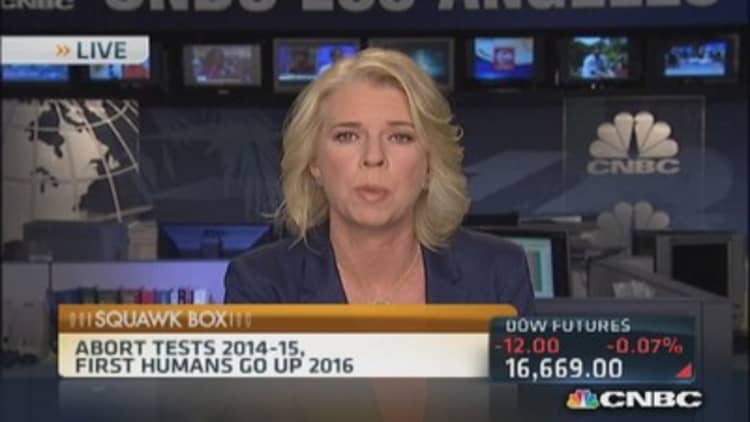
Last month Elon Musk wowed reporters on the floor of SpaceX's Hawthorne, California-based factory, pulling back the curtain on the spaceship that his commercial spaceflight company hopes will carry NASA astronauts to the International Space Station as soon as 2016. The unveil of the Dragon V2, as the spacecraft is known, couldn't have come at a better time. Just two weeks prior, Russia's deputy prime minister vowed to bar NASA from hitching rides to the ISS aboard Russian Soyuz spacecraft in retaliation for Western sanctions imposed on Russia in response to the the Ukraine crisis.
The fortuitous timing—along with the Dragon V2's sleek, futuristic design—could make the spacecraft an attractive option for NASA, which is also considering designs by Boeing and Sierra Nevada. But more important to SpaceX (CNBC's No. 1 Disruptor) is the advance toward a core company objective: reusability. Dragon V2—unveiled just a month after SpaceX demonstrated technologies key to developing a reusable first rocket stage—can be retrieved, refurbished and relaunched, a concept with the potential to completely upend the economics of a spaceflight industry where equipment costing hundreds of millions of dollars is most often discarded after a single use.
The latest rocket science
The reusable rocket stage is just the latest way SpaceX is disrupting a space launch industry in which it has already undercut its more traditional commercial launch competitors—including France's Arianespace and the Russian-U.S. joint venture International Launch Services (ILS)—by an estimated 25 percent to 35 percent, disrupting an industry that some analysts believe will be the biggest innovation economy in human history.
Read MoreThe company that wants to send you to space
As confidence in its technology has grown, so has market share; SpaceX now has more than 40 scheduled launches on its manifest through 2018, worth nearly $5 billion, revenues that—barring some kind of major failure—guarantee SpaceX's place as not only the leader of the emerging so-called NewSpace industry but a legitimate threat to the conventional aerospace firms that have dominated space launch for decades.
In little more than 10 years, SpaceX has taken an enterprise that hadn't changed appreciably since the 1960s and shifted the very ground upon which everyone in the space business—from global satellite manufacturers to legacy aerospace powerhouses to NASA—must now stand. Musk, SpaceX's CEO and founder, wants to drive costs down by another order of magnitude by developing reusable rocket stages, making sub-$10 million space access a reality. And if April's reusable rocket demonstration is any indication, SpaceX isn't yet done shaking up the industry.
Read MoreMars ahead? SpaceX unveils Dragon V2 capsule for astronaut trips
"It's definitely one of the most ambitious players in the NewSpace industry," said Jonathan Beland, a senior analyst with aerospace consultant Futron. "It's nearly the only one that has gone gung-ho straight into orbital space. They're well funded, they have a distinct vision, and they're playing the space launch industry game a little differently than the traditional players have done."

Who needs Russian spacecraft
SpaceX has largely done so by committing from the outset to trim launch costs, something the traditional commercial spaceflight industry has worried little about.
The commercial launch industry emerged in the 1980s and 1990s to fill a void as the U.S. government moved away from the commercial launch business. Companies like Arianespace and ILS have since developed reliable launch vehicles. But with no downward pressure on pricing or an impetus to develop more cost-effective technology, prices have remained high. While neither company advertises its prices, analyst consensus puts them somewhere around $100 million at the low end for an average launch. (SpaceX currently advertises launch prices of just $61.2 million for similar-sized payloads.)
When SpaceX emerged in 2002, it looked far less like a traditional space launch company and more like a Silicon Valley start-up. Engineers attacked technology challenges one component at a time, the way a software developer might. Designers embraced new technologies, like 3-D printing, advances in materials science and enhanced computer-modeling techniques. Working closely with NASA, SpaceX built industry confidence in its technologies and operational capability through a culture of transparency uncommon in the industry.
Read MoreA 21st-century collision course in space
But the greatest difference between SpaceX and its peers was its insistence that space access doesn't have to be so expensive.
"[Traditional space launch companies] really haven't faced serious competition or anything radically new in decades," said Steve Jurvetson, a partner at Silicon Valley VC firm Draper Fisher Jurvetson, which invests in SpaceX, along with other commercial space companies. "SpaceX struck me as an elegant and unique approach that was very different from that of the traditional industry, where everyone was just going along with bloated cost structures and no motivation to innovate."
Twelve years and three launches to the International Space Station later, there's still no real competition in the commercial launch business, because no other company can compete with SpaceX. Last month at the Berlin Air Show, the head of European aerospace giant Airbusappealed to European countries to overhaul the continent's launch industry to avoid becoming irrelevant, mentioning SpaceX by name.
Earlier this year, Arianespace's CEO told the European Space Agency the company may require additional subsidies to remain competitive in the commercial satellite launch market. SpaceX continues to nibble away at the $5.4 billion commercial satellite launch market, and it may soon start taking much bigger bites.
Read MoreSpaceX CEO Musk suing to open up national security launches
Cracking the satellite market
Generally speaking, SpaceX is No. 1 because it builds on the principles that define the NewSpace industry. ... It targets a diverse customer base from commercial satellite companies to NASA to universities to smaller companies. It lives and breathes on taking innovative products to market.Richard M. DavidCEO, NewSpace Global
"The fact that SpaceX is now winning opportunities to launch satellites globally is a huge deal," said Carissa Christensen, managing partner at commercial space industry consulting firm Tauri Group. "They've changed the conversation and shifted the ground to focus on price from the very beginning. And now they're starting to get a piece of this market that the U.S. hasn't been in for years."
Indeed, the U.S. went from launching basically all the world's commercial satellites prior to the 1980s to launching virtually none of them a decade later as launch costs spiraled and companies like Arianespace offered less-expensive options. Currently, the U.S. government regularly spends upward of $200 million launching its most expensive and sensitive satellites into orbit, hiring United Launch Alliance (ULA), a joint venture between Lockheed Martin and Boeing, under non-competitive contracts to do so.
SpaceX may soon be eating away at ULA's market as well, one worth tens of billions of dollars. In April, SpaceX filed a lawsuit against the U.S. Air Force demanding it open up a block of 36 launches recently awarded to ULA under an exclusive contract. ULA claims it requires $225 million to launch a military satellite into orbit. SpaceX says it can do so for $100 million per launch, making it an appealing option if it can force the government to open the contracts for competition. Global events may work in the company's favor as well, as tensions continue to build between the U.S. and Russia, from which ULA sources some of its rocket engines.
"If they can get access to the military launch market, that is a substantial market," Christensen said. "It also has historically been a fairly predictable and stable market, and that could be very significant for SpaceX."
Read MoreHave an investing idea? Build your own ETF?
When SpaceX's next-gen heavy-lift rocket, the Falcon Heavy, flies for the first time early next year, SpaceX will also have the world's largest rocket in its portfolio, preparing it to compete with anyone in the marketplace on capability while leaving everyone behind on price, thanks to full ownership of its own product ecosystem.
Therein lies another major differentiator between SpaceX and its more traditional rivals: Rather than using old technologies or integrating existing products into a new product, SpaceX largely creates its own. It's a technology company doing business as a space services provider.
Trailblazer for flyboys
"Generally speaking, SpaceX is No. 1 because it builds on the principles that define the NewSpace industry," said Richard M. David, CEO of space industry analysis firm NewSpace Global, which places SpaceX at the very top of its NSG 100 index of the top privately-held commercial space companies. "It has strong management with an impressive track record. It targets a diverse customer base from commercial satellite companies to NASA to universities to smaller companies. It's backed by credible investor dollars—we're talking Silicon Valley venture capital firms like Draper Fisher Jurvetson, Founder's Fund, Sequoia, Capricorn. But most of all, it lives and breathes on taking innovative products to market."
SpaceX doesn't have to do anything to remain the planet's most cost-effective option for commercial launch in the near term. Even without a further reduction in launch costs, the small commercial satellite industry is picking up steam (NewSpace Global analysts think it could breach the $1 billion mark this year), as companies that aren't particularly "space companies" seek access to space-based technologies that can enhance their business.
Last week Google acquired Skybox Imaging, a maker of small imaging satellites, for a reported half-billion dollars, and last week news broke that the search giant plans to spend $1 billion putting 180 small satellites in the sky to provide Internet to unconnected corners of the world.
The potential for SpaceX to capture large chunks of the small satellite business is massive. But moreover, as access to space becomes increasingly cheap and increasingly reliable, the market for launch will continue to create new opportunities that will feed the launch market.
"It's not just the launch vehicles themselves that are disruptive," Jurvetson said. "It's the known, low price of launch and the fact that it could go lower still. It's motivating entrepreneurs on the satellite side. You have everything from start-ups to nonprofit organizations that are thinking and executing on plans for space. That was unthinkable just a few years ago."

SpaceX's revolution could still derail. This is rocket science, a risky business with plenty of room for error. But so far, the company has managed to ably walk the razor-thin line between risk-taking and confidence-building. Barring any setbacks, it will continue that walk when it launches another commercial satellite mission (SpaceX's 12th trip to orbit) sometime in the next few weeks when it again attempts to bring a first rocket stage safely back to Earth, taking another step along the path toward trimming launch costs by a further order of magnitude and upending the economics of space flight for a second time.
"That's the magic piece," Christensen said. "If they can make that magic work and save tens of millions per launch, that would be a really big deal."
—by Clay Dillow, special to CNBC.com





